The Intel Core i3-7350K (60W) Review: Almost a Core i7-2600K
by Ian Cutress on February 3, 2017 8:00 AM ESTGrand Theft Auto V
The highly anticipated iteration of the Grand Theft Auto franchise finally hit the shelves on April 14th 2015, with both AMD and NVIDIA in tow to help optimize the title. GTA doesn’t provide graphical presets, but opens up the options to users and extends the boundaries by pushing even the hardest systems to the limit using Rockstar’s Advanced Game Engine. Whether the user is flying high in the mountains with long draw distances or dealing with assorted trash in the city, when cranked up to maximum it creates stunning visuals but hard work for both the CPU and the GPU.
For our test we have scripted a version of the in-game benchmark, relying only on the final part which combines a flight scene along with an in-city drive-by followed by a tanker explosion. For low end systems we test at 720p on the lowest settings, whereas mid and high end graphics play at 1080p with very high settings across the board. We record both the average frame rate and the percentage of frames under 60 FPS (16.6ms).
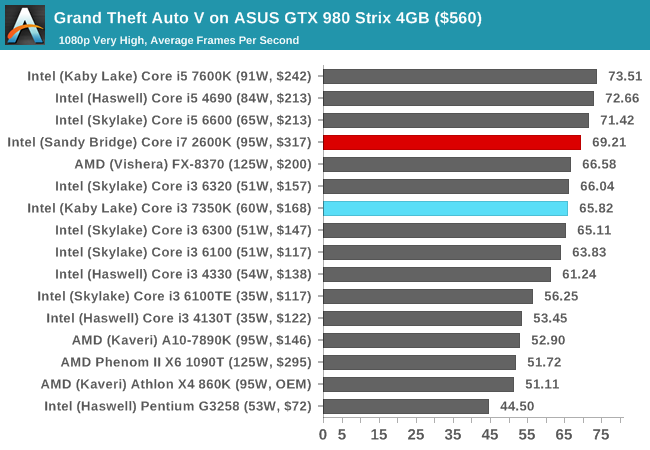
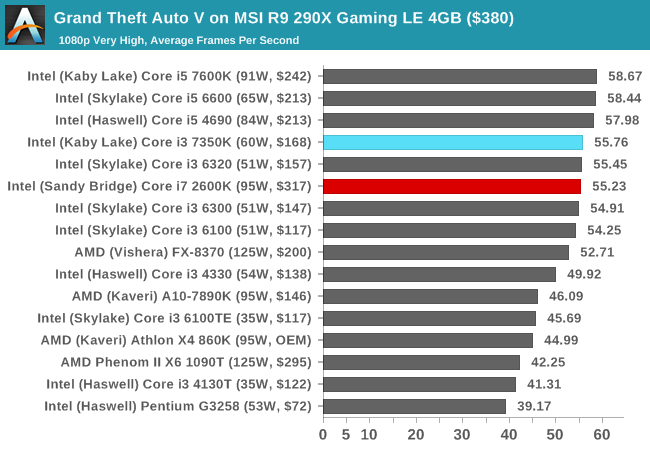
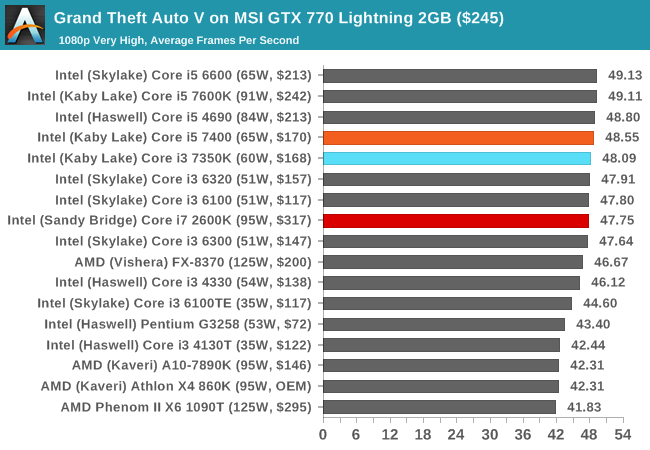

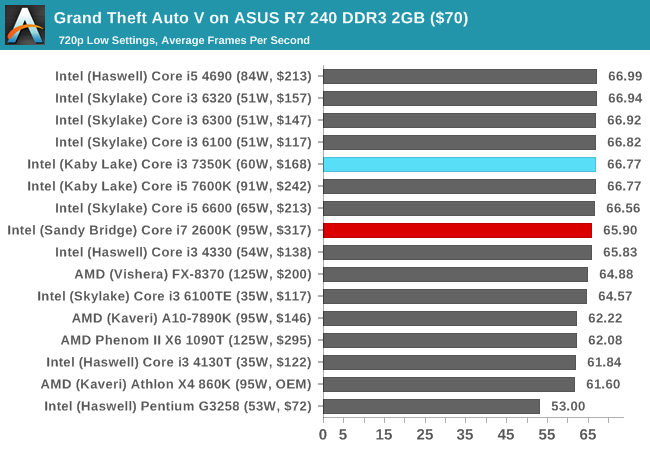
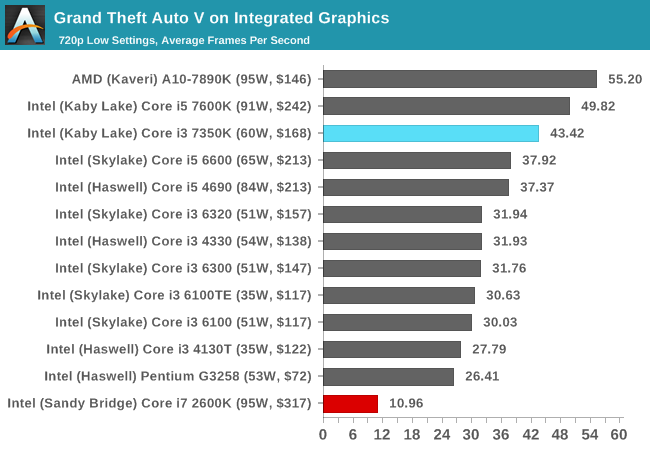
The older Core i7-2600K eeks out a small ~5 FPS advantage over the Core i3 when running a GTX 980 at 1080p maximum settings, but with all other GPUs the differences are minimal. With integrated graphics, the Core i3 shows it can pummel the older IGP into the ground.











186 Comments
View All Comments
silverblue - Saturday, February 4, 2017 - link
It's a bit weird, but most of them are within margin of error.WoodyBL - Saturday, February 4, 2017 - link
Am I the only one noticing that the i5-4690 was beating the i5-7600k in a lot of benchmarks? I'm having a hard time processing how that was even possible...fanofanand - Sunday, February 5, 2017 - link
Wasn't the 4690 Devil's Canyon? Similar IPC higher clocks I would assume. Most of the changes lately have been hardware decoders/encoders and I/o changes. Intel takes baby steps because it can, hopefully that changes with Ryzen.WoodyBL - Saturday, February 4, 2017 - link
Am I the only one noticing that the i5-4690 was beating the i5-7600k in a lot of benchmarks? I'm having a hard time processing how that was even possible...yankeeDDL - Saturday, February 4, 2017 - link
Glad to see that my 2 years old A10 still trashes anything Intel on integrated graphics.Gothmoth - Saturday, February 4, 2017 - link
no wonder intel is not selling to consumers, complaining about stagnation.the money they make comes from enterprise i guess.
i have not updated my sandy bridge for 6 years.
and i will not until intel gives me a reason.. this is only babysteps.
i had to cash out 1200 euro for a new mobo, cpu, ram, cooler... and for what.... 30% more performance..... meh
TelstarTOS - Saturday, February 4, 2017 - link
"Responsiveness? Top class."No way. It will suck in heavy multitasking.
synth0 - Sunday, February 5, 2017 - link
This is how good a 2011 chip really is!This shows there really isn't much sense to upgrade a PC anymore, and with time it will get even less sense to invest money for an upgrade. What will be in 2024? Are we entering into a stalemate in the PC area?
lopri - Sunday, February 5, 2017 - link
An excellent review but I would rather get a 7600K. Oh, wait. I already have something similar: 2600K.Bullwinkle J Moose - Sunday, February 5, 2017 - link
"The Intel Core i3-7350K (60W) Review: Almost a Core i7-2600K"---------------------------------------------------------------------------------------
.....and not even CLOSE to a Sandy Bridge!
Can the Intel Core i3-7350K use my Optical port in DRM crippled Windows 10 for Audio Production?
Show me how!
Can I record what I hear on the desktop with the DRM crippling API's found in Windows Vista / 7 / 8 and 10 ?
Show me how!
Will it boot "directly" to Windows XP faster than I can on my 35 watt dualcore Sandy Bridge (3-seconds on a Samsung 850 Pro SSD) so I CAN use my optical ports and record whatever I want without a DRM crippled Spyware Platform, or do the new motherboards prevent me from booting to a NON-crippled O.S. like my copy of Windows XP?
Well?
Should I "upgrade" to a crippled platform that prevents me from doing ANYTHING I want to do, but allows me to do only what Microsoft graciously allows me to do?
........ and explain to me again why I should pay more for my own enslavement?